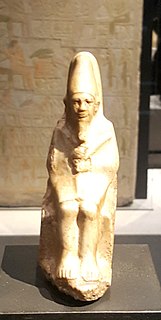
Nynetjer is the Horus name of the third pharaoh of the Second Dynasty of Egypt. The length of his reign is unknown. The Turin Canon suggests an improbable reign of 96 years and Egyptian historian Manetho suggested that Nynetjer's reign lasted 47 years. Egyptologists question both statements as misinterpretations or exaggerations. They generally credit Nynetjer with a reign of either 43 years or 45 years. Their estimation is based on the reconstructions of the well known Palermo Stone inscription reporting the years 7–21, the Cairo Stone inscription reporting the years 36–44. According to different authors, Nynetjer ruled Egypt from c. 2850 BC to 2760 BC or later from c. 2760 BC to 2715 BC.
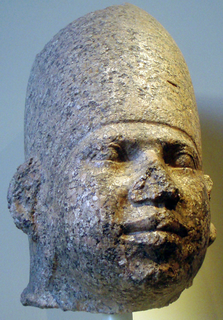
Huni was an ancient Egyptian king and the last pharaoh of the Third Dynasty of Egypt during the Old Kingdom period. Following the Turin king list, he is commonly credited with a reign of 24 years, ending c. 2613 BC.

Khaba was a pharaoh of Ancient Egypt, active during the 3rd Dynasty of the Old Kingdom period. The exact time during which Khaba ruled is unknown but may have been around 2670 BC, and almost definitely towards the end of the dynasty.

Iry-Hor or Ro was a predynastic pharaoh of Upper Egypt during the 32nd century BC. Iry-Hor's existence was debated, with the Egyptologist Toby Wilkinson contesting the reading and signification of his name. However, continuing excavations at Abydos in the 1980s and 1990s and the discovery in 2012 of an inscription of Iry-Hor in the Sinai confirmed his existence. Iry-Hor is the earliest ruler of Egypt known by name and is sometimes cited as the earliest-living historical person known by name.
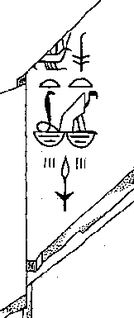
Weneg, also known as Weneg-Nebty, is the throne name of an early Egyptian king, who ruled during the Second Dynasty. Although his chronological position is clear to Egyptologists, it is unclear for how long King Weneg ruled. It is also unclear as to which of the archaeologically identified Horus-kings corresponds to Weneg.
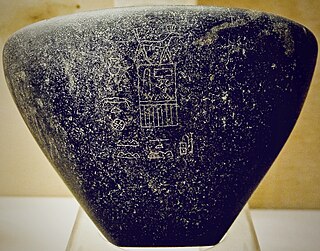
Seth-Peribsen is the serekh name of an early Egyptian monarch (pharaoh), who ruled during the Second Dynasty of Egypt. His chronological position within this dynasty is unknown and it is disputed who ruled both before and after him. The duration of his reign is also unknown.

Anedjib, more correctly Adjib and also known as Hor-Anedjib, Hor-Adjib and Enezib, is the Horus name of an early Egyptian king who ruled during the 1st Dynasty. The Egyptian historian Manetho named him "Miebîdós" and credited him with a reign of 26 years, whilst the Royal Canon of Turin credited him with an implausible reign of 74 years. Egyptologists and historians now consider both records to be exaggerations and generally credit Adjib with a reign of 8–10 years.

Sekhemib-Perenma'at, is the Horus name of an early Egyptian king who ruled during the 2nd Dynasty. Similar to his predecessor, successor or co-ruler Seth-Peribsen, Sekhemib is contemporarily well attested in archaeological records, but he does not appear in any posthumous document. The exact length of his reign is unknown and his burial site has yet to be found.
Günter Dreyer was an Egyptologist at the German Archaeological Institute. In southern Egypt, Dreyer discovered records of linen and oil deliveries which have been carbon-dated to between 3300 BCE and 3200 BCE, predating the Dynastic Period.
Nimaathap was an ancient Egyptian queen consort at the transition time from 2nd Dynasty to 3rd Dynasty. Nimaathap may have acted as regent for her son Djoser.

The Horus name is the oldest known and used crest of ancient Egyptian rulers. It belongs to the "great five names" of an Egyptian pharaoh. However, modern Egyptologists and linguists are starting to prefer the more neutral term: the "serekh name". This is because not every pharaoh placed the falcon, which symbolizes the deity Horus, atop his serekh.
Meritites I was an ancient Egyptian queen of the 4th Dynasty. Her name means "Beloved of her Father". Several of her titles are known from a stela found at Giza. She was buried in the middle Queen’s Pyramid in Giza.
Khenthap was allegedly a queen of Ancient Egypt. She is said to have lived during the 1st Dynasty. Her historical figure is very obscure, since there are no contemporary sources for her name. She appears only once in a much later inscription.
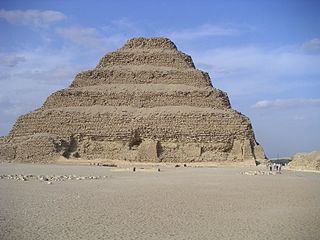
The Third Dynasty of ancient Egypt is the first dynasty of the Old Kingdom. Other dynasties of the Old Kingdom include the Fourth, Fifth and Sixth. The capital during the period of the Old Kingdom was at Memphis.

Horus Bird, also known as Horus-Ba, is the serekh-name of a pharaoh who may have had a very short reign between the First and Second Dynasty of Egypt.
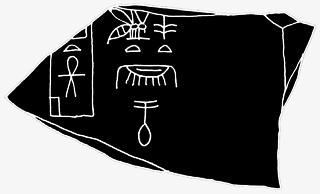
The prenomen, cartouche name or throne name of ancient Egypt was one of the five royal names of pharaohs. The first pharaoh to have a Sedge and Bee name was Den during the First Dynasty.
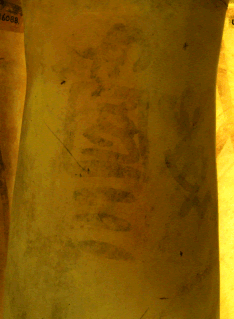
Crocodile is the provisional name of a predynastic ruler, who might have ruled during the late Naqada III epoch. The few alleged ink inscriptions showing his name are drawn very sloppily, and the reading and thus whole existence of king "Crocodile" are highly disputed. His tomb is unknown.
Akhetaa was an ancient Egyptian high official during the mid to late 3rd Dynasty. He is mostly known for his tomb inscriptions, which refer to various seldom used titles as well as to the shadowy king Nebka, in whose cult Akhetaa served.
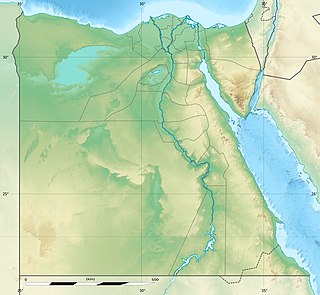
The Pyramid of Elephantine is part of a group of seven very similar small step pyramids, along with the pyramids at Edfu South, el-Kula, Naqada, Saujet el-Meitin, Seila, and Sinki. All of these were built far from the main centres of Egypt and are very poorly understood. The Pyramid of Elephantine is located in the northwest part of the Old Kingdom city on the south end of the island of Elephantine in the Nile. The structure was discovered in 1907, but it could only be identified as a pyramid after excavations by the German Archaeological Institute in 1978–79.
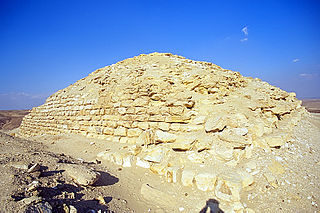
The Pyramid of Seila is one of a group of seven small step pyramids which are very similar to one another, along with the Edfu South Pyramid, the Pyramid of Elephantine, the Pyramid of El-Kula, the Pyramid of Naqada, the Pyramid of Saujet el-Meitin, and the Pyramid of Sinki. These pyramids were all built far from the major centres of Egypt and very little is known about them. The pyramid is located on an outcrop between the Faiyum Oasis and the Nile valley, about 6 km north of the motorway from Wasta to Faiyum. Its builder may have been Snefru, the founder of the Fourth dynasty. It was discovered in 1889/1890 by Flinders Petrie and revisited in 1898 by Ludwig Borchardt.














